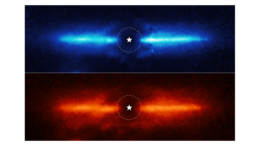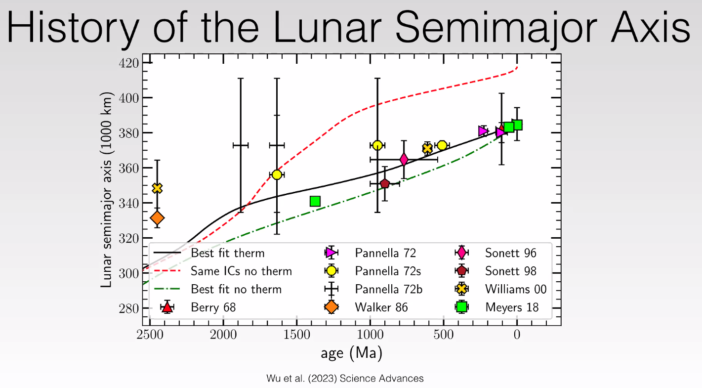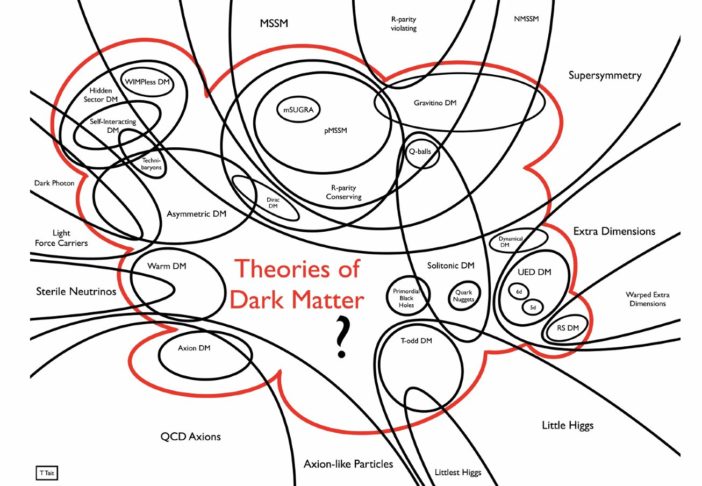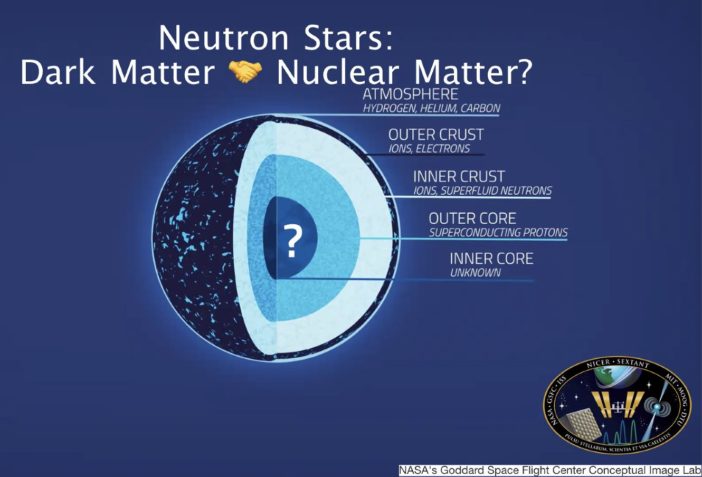Editor’s Note: This week we’re at the 241st AAS meeting in Seattle, WA, and online. Along with a team of authors from Astrobites, we will be writing updates on selected events at the meeting and posting each day. Follow along here or at astrobites.com for daily summaries, or follow @astrobites on Twitter for live coverage. The usual posting schedule for AAS Nova will resume on January 18th.
Table of Contents:
- Royal Astronomical Society Gold Medal Lecture: George Efstathiou (University of Cambridge)
- Press Conference: Building Systems in Our Local Universe
- Dannie Heineman Prize Lecture: Norman Murray (CITA)
- STEM Mentorship and Underrepresented Minoritized Students
- Press Conference: Discoveries in the Milky Way’s Backyard and in the Universe at Large
- Plenary Lecture: Chanda Prescod-Weinstein (University of New Hampshire)
- Plenary Lecture: Sabrina Stierwalt (Occidental College)
- Astronomy in Indigenous Communities Special Session [from Tuesday, January 10th]
Royal Astronomical Society Gold Medal Lecture: George Efstathiou (University of Cambridge) (by Yoni Brande)
Professor George Efstathiou is the 2022 Royal Astronomical Society Gold Medal awardee, and as part of this honor, he was invited to give one of the plenary talks here at the winter AAS meeting. Prof. Efstathiou is Professor of Astronomy at the Institute of Astronomy at Cambridge, and he was director of the Institute from 2004 to 2008. His research focuses on cosmology, ranging from simulations of large scale cosmic structure formation to anisotropies in the cosmic microwave background.
Prof. Efstathiou structured his talk around paradigm shifts in cosmology. Fifty-seven years ago, in 1965, Penzias and Wilson discovered the cosmic microwave background (CMB), providing the strongest evidence for the Big Bang theory of the origin of the universe. When Prof. Efstathiou started his PhD a decade later, he worked on early computational models of cosmological structure formation, taking weeks to run on room-sized computers. For comparison, he re-ran some of those models on his laptop, but they only took 30 seconds!
Soon after, inflationary theory was the next paradigm shift in cosmology, which preserved causality in the early universe, linking now-unrelated areas of space with each other just after the universe’s formation. However, while inflation explained the current scale of the fluctuations in the CMB, their origin was still unclear, leading to the development of the modern theory for the quantum generation of those fluctuations, giving modelers initial conditions to tweak for their simulations!
Working from the cold dark matter (CDM) model, Prof. Efstathiou and his group produced a suite of simulations of current-day large scale structure and then conducted a big photometric survey to test their assumptions. They found even more structure in the current universe than they’d predicted, which could only be resolved by a positive cosmological constant, the simplest explanation for dark energy (the Lambda-CDM model).
These theoretical models were quickly tested with even more sophisticated observations, with COBE, WMAP, and Planck measuring the CMB at incredible resolutions, showing spatial invariance and causal connection across the entire sky, with the amplitudes of the fluctuations lending even more support for LCDM and closely matching theoretical predictions.
So, do we actually have a standard model of cosmology? Yes, with some caveats: we don’t really understand inflation, we don’t have a dark matter particle, and we don’t understand dark energy. This raises an uncomfortable question: Is LCDM just a fitting function? Prof. Efstathiou is a bit more optimistic. Each point in the model has lots of indirect observational evidence, so there should be some truth in the model even if we don’t deeply understand the individual ingredients.
A lot of the observational problems need to be resolved. It’s been 25 years since dark energy, the last paradigm shift in cosmology, and who knows where the next one will come from. It’s unlikely that a theorist will come up with something groundbreaking out of nowhere. The Hubble tension still needs to be resolved, and it might be impossible to detect primordial gravitational waves from the CMB. Prof. Efstathiou’s best bet is that the next paradigm shift will be the detection of dark matter. Hopefully, in another 57 years, the RAS Gold Medal winner will step onto the stage at the AAS meeting and give a similar talk, all about how we used to not understand inflation!
Live tweets of this session by Yoni Brande.
Press Conference: Building Systems in Our Local Universe (by Briley Lewis)
This morning’s press conference tackled the building blocks of our universe, from star-forming regions to planet-forming debris disks — including multiple new exciting results from JWST.
Kellen Lawson (NASA Goddard Space Flight Center) presented JWST NIRCam observations of the debris disk AU Mic, a well-studied edge on disk with a few planets known from transits. The new JWST images reveal the disk in never-before-seen wavelengths, which are still undergoing analysis. The team didn’t spot any planets, but their sensitivity curves revealed that JWST is now sensitive to solar-system-mass planets at solar system scales, which is exciting!Jacob Lustig-Yaeger and Erin May (Johns Hopkins University Applied Physics Laboratory) presented new observations of transiting rocky exoplanet LHS 475b, JWST’s first exoplanet discovery and a previously unconfirmed TESS Object of Interest (TOI). This planet is very similar in size to Earth, but much warmer — and with transmission spectroscopy, they peered into its atmosphere. Its spectrum is remarkably flat, consistent with either a fully carbon dioxide atmosphere or even no atmosphere at all. More observations are needed to figure it out!
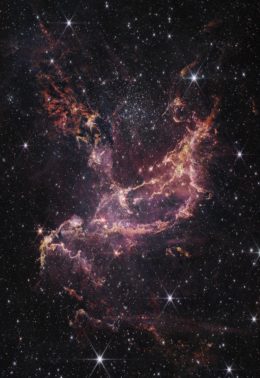
A newly revealed image of star-forming region NGC 346 from JWST. [SCIENCE: NASA, ESA, CSA, Olivia C. Jones (UK ATC), Guido De Marchi (ESTEC), Margaret Meixner (USRA)
IMAGE PROCESSING: Alyssa Pagan (STScI), Nolan Habel (USRA), Laura Lenkić (USRA), Laurie E. U. Chu (NASA Ames)]
Ümit Kavak (Universities Space Research Association) continued on the theme of star formation, showing data from the airborne observatory SOFIA that reveal huge outflows from the Trapezium stars within the Orion Nebula moving over 60,000 miles per hour. And last but not least, Theo O’Neill (University of Virginia) displayed a new map of the local bubble’s magnetic field. The local bubble was created a long time ago from supernovae (not from the Sun!), and the Sun just happens to be in the middle of it. This map is going to be a useful new tool for astronomers exploring how magnetic fields affect star formation.
Dannie Heineman Prize Lecture: Norman Murray (CITA) (by Graham Doskoch)
Here’s a simple question: Why does one day on Earth last 24 hours? That was the focus of the plenary lecture by Prof. Norman Murray, winner of the Dannie Heineman Prize. It might seem easy to answer, but half a century of work has shown it to be anything but. The solution requires an understanding of tidal forces, atmospheric modeling, and a willingness to think about clams.
Prof. Murray took us to the Pacific Northwest. Clams there grow their shells at different rates depending on nutrient and sediment deposition in the shallows of the ocean; if a clam is eating, it’s growing. This in turn is connected to the height of the tides. By looking at the size of bands in a clam’s shell, you can learn about how the tides have varied over time — which in turn tells you about the orbit of the Moon, since it’s one of the two celestial bodies that cause gravitational tides on Earth.
Clams haven’t lived on Earth since the dawn of time, so if you want to go back further, you need to check the geologic record. By probing the composition of strata, you can grab information about the history of Earth’s climate, from which you can in turn extract data showing the precession of Earth and the Moon. More analysis then lets you model the change in the Moon’s semimajor axis.
If that wasn’t complicated enough, Prof. Murray pointed out that there’s another force affecting Earth’s angular momentum: thermal tides. As the Sun heats Earth’s atmosphere, more complex interactions cause changes in pressure, giving rise to a tidal perturbation. In short, gravitational tides from the Moon extract angular momentum from Earth; thermal tides, on the other hand, add angular momentum.
Some fluid dynamics modeling shows how waves can propagate in the atmosphere, driven by these effects. Prof. Murray showed that they’re subject to a particular resonance determined in part by the speed of sound in the atmosphere. This resonance, coupled with thermal and gravitational tides, eventually drove Earth’s angular momentum to its current point, corresponding to a day of roughly 24 hours. The balance has lasted about 1 billion years, give or take.
There are other interesting facts you can derive from modeling; for example, there’s a temperature dependence on all of this. Plus, by simulating the angular momentum transfers, you can model evolution of the Moon’s orbit — in particular, the change in the Moon’s semimajor axis over time. It’s model-dependent, but the results Prof. Murray presents match experimental data points, to varying degrees of success.
Live tweets of this session by Graham Doskoch.STEM Mentorship and Underrepresented Minoritized Students (by Isabella Trierweiler)
This special session included four views on the intersections of mentoring, mental health, and diversity, equity, and inclusion (DEI) work. The first speaker was Jennifer Bates, a social worker and program manager for the Broadening Participation initiative at the National Radio Astronomy Observatory (NRAO). She introduced the motivations for the Broadening Participation Programs, which include five research and mentoring programs to increase representation of students with underrepresented identities in the sciences. She pointed out multiple studies of stress and anxiety amongst college students in general, as well as specifically for BIPOC and LGBTQIA+ students, showing that students or marginalized identities are much more likely to experience discrimination and exclusion but less likely to receive adequate mental health care. Danielle Rowland, who also works on the Broadening Participation Programs at NRAO, then spoke about the NAC (National Astronomy Consortium) program. The program places students into cooperative teams to work on summer research projects. Students also receive mentoring and professional development support and are eligible for further research projects, travel grants, and bridge support for graduate school after their participation in the program.
Timothy Paglione shared his experience running AstroCom NYC, a CUNY program to provide support and mentoring for astrophysics students. The students are paired with research and career mentors and work on research at the American Museum of Natural History. The CUNY system is very extensive, with 25 campuses including senior and community colleges, graduate programs, and professional colleges. The program has grown along with its students’ needs, evolving the approaches to preparing students for graduate school as well as industry jobs and adding a focus on mental health. One of the unique aspects of AstroCom NYC is that the program has a counselor available to serve students’ mental health needs, so that students can attend one-on-one counseling sessions or join a “Solidarity Group.”
Finally, David Morris spoke about his experience growing the physics and astronomy program at the University of Virgin Islands (UVI). UVI is a relatively small university with about 1,500 students, most of whom grew up locally. The degree program in physics, with a concentration in astronomy, just started in 2015 and grew rapidly in its first few years. However, the program faced difficulties when Covid began, and both enrollment in UVI and in the physics program went into a decline. In order to get students involved again and improve recruitment to the physics major, the department started a student-run High Altitude Balloon project. The intensive hands-on experience helped to renew enthusiasm for research amongst the students while giving them the opportunity to work with scientists at other institutions.
Live tweets of this session by Isabella Trierweiler.
Press Conference: Discoveries in the Milky Way’s Backyard and in the Universe at Large (by Mark Popinchalk)
If you are feeling pedantic, you might point out that a press conference called “Discoveries in the Milky Way’s Backyard and in the Universe at Large,” could be more simply called “Discoveries.” But a better name might have been “Galaxies,” as that was the through line between all the presentations.
First was Burçin Mutlu-Pakdil who announced the discovery of three ultra faint galaxies beyond the local group. Ultra faint dwarf galaxies are the most dark matter dominated objects in the galaxy, but are (by definition) faint and small, which makes them challenging to observe. All the previous examples were around galaxies in our local group (essentially the Milky Way, Andromeda, and smaller friends), but the authors identified three new ones around NGC 253 using Hubble images.
Then Dong-Woo Kim introduced us (or at least me) to XBONGs, X-ray Bright Optically Normal Galaxies. They are just that, galaxy-like objects that look normal in optical light, but are extremely bright in X-ray. By combining Chandra data with objects classified as galaxies in SDSS, they found 820 XBONGs and attempted to understand what they were. 50% of them are almost certainly obscured active galactic nuclei, where the optical light is blocked by gas and dust but the X-ray light is penetrating through. The other half is split between likely being hot gas clouds and maybe diluted active galactic nuclei. In the future, they will use more Chandra observations and double the number of XBONGs (so fun to write) for them to classify, and hopefully understand the phenomenon.
Kaixiang Wang then set about revealing the origin of ultra compact dwarf galaxies (UCDs). These objects seem to blur the definition between globular clusters and dwarf galaxies; they have a similar mass to the latter, but their size is an order of magnitude smaller, closer to the former. One theory is that they are former dwarf galaxies that have had their outer layers stripped by a violent tidal interaction in the past, leaving only the nuclear star cluster. The main result is that they found some objects with tidal disruptions and envelopes — smoking-gun evidence that at least some UCDs originate from disrupted nucleated dwarf galaxies.
We then moved from smaller galaxies to some of the bigger players in our own Local Group, the galaxies that are near the Milky Way. Kat Barger started by warning us about the dangers of supernovae winds pushing out gas in the Large Magellanic Cloud galaxy (LMC). Really the danger is to the LMC, as she showed that the winds were heating up gas and shooting it out of the LMC, at least 4.5 times the amount of gas that the LMC is using to make stars and planets! That’s not necessarily bad for its future star formation rate, as the gas might cool and fall back towards the small galaxy, except there is a much bigger galaxy nearby — our own Milky Way! The presentation ended by showing that there is already a large outflow from the LMC that is being tidally pulled by the Milky Way. Thanks for the gas, LMC!
Finally, Adam Smercina wanted to look at spiral structure in low-mass galaxies, such as the LMC, but it’s not a good example in part because of the tidal influences of the Milky Way. So instead he focused on the Triangulum galaxy, another diminutive neighbor. Using a Hubble survey program called PHATTER, he was able to identify 22 million stars individually, and sort them into rough bins of youngest, young, intermediate and old. When he looked at how those populations were positioned in space, the young stars show a clear spiral structure, while the older ones lose their spiralness! This isn’t necessarily an evolutionary sequence, as the older ones might have been disrupted into their blobby distribution. Rather, it’s more likely a trace of the gas in the galaxy, which behaves differently than the stars do.
Overall it was great to see some new results from galaxies that were indeed in the Milky Way’s backyard and beyond!
Live tweets of this session by Mark Popinchalk.
Plenary Lecture: Chanda Prescod-Weinstein (University of New Hampshire) (by Isabella Trierweiler)
The theme throughout Dr. Chanda Prescod-Weinstein’s plenary talk was that astrophysics and particle physics will become increasingly entangled as the quest to understand dark matter moves forward. Dr. Prescod-Weinstein is a Professor of Physics and a Core Faculty Member in Women’s and Gender Studies at the University of New Hampshire, and author of the popular science book “The Disordered Cosmos: A Journey into Dark Matter, Spacetime, and Dreams Deferred.” She focused her plenary talk on the role of astrophysics in some of the most pressing open questions regarding dark matter.
Dr. Prescod-Weinstein began her talk by introducing dark matter, the mass that we know is prevalent throughout the universe due to its gravitational influence but which does not seem to be explained by any particles in our current standard model. Astrophysical proof of dark matter has existed for some time — we see it in the flattening of galaxy rotation curves, in lensed galaxies imaged by Hubble and JWST, and in the features of the cosmic microwave background. Based on these observations, and through testing dark matter in cosmological simulations, we know that dark matter doesn’t interact with photons and is cold and slow moving.
She stressed that understanding dark matter is not just a goal for particle physicists — astronomers have stakes in the outcome, too. One of the main examples lies in galaxies, whose formation and evolution is deeply dependent on the dark matter halos they reside in. To truly understand the physics of galaxies and their satellites, we need to understand what dark matter is and how it influences its environment.
Amongst the possible components of dark matter, which span in scale from miniscule particles to multiple-solar-mass black holes, Dr. Prescod Weinstein spoke about two promising options: axions and asymmetric dark matter. Axions are theoretical particles that were proposed to solve symmetry issues in quantum field theory. The particles were proposed in the 1980s, but experiments have just recently become capable of searching for them. The idea behind asymmetric dark matter is that, much like particles and anti-particles, dark matter and anti-dark matter both formed in the universe, and in the process of colliding and annihilating, only dark matter was left to survive to present day.
Dr. Prescod Weinstein presented a few astrophysical probes related to each of these potential dark matter components. Interestingly, astronomers can expect neutron stars to play a big role in future dark matter studies. The inner cores of neutron stars are very mysterious, but it could be that they contain dark matter, not just nuclear matter. Additionally, it’s possible that asymmetric dark matter can be made within neutron stars. More higher-energy missions could help us clarify the neutron star/dark matter relation! Regarding axions, Dr. Prescod Weinstein showed that astronomical-scale manifestations of the particle are certainly possible! Axions are a type of particle called bosons, and because they are bosons they have a special property when cooled to very low temperatures. When bosons (and axions) are near 0 Kelvin they become Bose-Einstein condensates, a particular state of matter where many individual particles group together so that quantum systems can be viewed macroscopically. The exact size of the condensate would depend on the mass of the particle, but axion Bose-Einstein condensates are theorized to be at least as large as an asteroid!To move forward in these theories, Dr. Prescod Weinstein emphasized the importance of new instruments such as STROBE-X and the Vera Rubin Observatory. Observations from these telescopes will be crucial in fully utilizing astrophysical probes in the search for dark matter!
Live tweets of this session by Isabella Trierweiler.
Plenary Lecture: Sabrina Stierwalt (Occidental College)
Dr. Stierwalt began her talk with an overview of dwarf galaxies. She explained that we have recorded evidence of our ancestors observing the Small and Large Magellanic Clouds — two of the most famous dwarf galaxies — dating back to prehistoric times. However, we didn’t know what they or other dwarf galaxies were until Harlow Shapley observed the Sculptor Dwarf Galaxy in 1937.
Moving into the bulk of her talk, Dr. Stierwalt outlined four reasons why dwarf galaxies are both very hard and very important to study:
- Dwarf galaxies are both small and faint — two characteristics that can greatly limit the observability of an astronomical object. However, because they are small and faint, we can use them to place stricter constraints on galaxy structure. For instance, we know roughly where dwarf galaxies should be in relation to the Milky Way and how many of them there should be, so if we compare the theoretical distribution to what we actually observe, we can determine how much dark matter must be present to reconcile the difference.
- Dwarf galaxies are strongly affected by stellar feedback because their gravitational wells are shallow. In other words, since they’re smaller than other galaxies, they have less gravity and are more affected by events such as supernovae that create turbulence in the interstellar medium. Studying the effects of stellar feedback can tell us more about both the mechanisms creating the feedback and the structure of the dwarf galaxies themselves. This is especially true in relation to dark matter, since we see dwarf galaxies with both low and high amounts of dark matter, and those with seemingly high amounts of dark matter tend to be more isolated, leading astronomers to wonder if stellar feedback is somehow stripping the dwarf galaxies of dark matter.
- Dwarf galaxies have low metallicities, so their compositions are similar to those of the highest redshift — i.e., the oldest — galaxies. This similarity means they can give us an idea of how star formation and stellar feedback occurred in the earliest populations. They can also give us insight into how mass loss occurs in low-metallicity stars, and help us discover techniques to find intermediate active galactic nuclei.
- Dwarf galaxies are heavily influenced by their environment. In other words, they’re very sensitive to what’s happening around them chemically and dynamically. Mergers of dwarf galaxies, for example, are much more likely to occur than mergers of large galaxies, and have different results. Dwarf galaxy mergers have starbursts occurring earlier in the merger than in mergers of larger galaxies, for example, and create more evenly distributed stars.
In closing, Dr. Stierwalt briefly discussed how upcoming surveys with the Rubin Observatory and the Nancy Grace Roman Space Telescope will increase the number of known dwarf galaxies. Additionally, follow-up observations of known dwarf galaxies using JWST will tell us even more about their dynamics and characteristics. Simulations of dwarf galaxy mergers — thought to be the progenitors of larger galaxies such as the Milky Way — are also becoming more and more accurate as we learn more. It’s an exciting time to be studying these small but mighty galaxies!
Live tweets of this session by Ali Crisp.
Astronomy in Indigenous Communities Special Session [from Tuesday, January 10th](by Macy Huston)
This session was the third of three events at AAS 241 relating to Community Models of Astronomy, following a workshop January 5–6 and the plenary panel on Monday.
Christine Matsuda (Maunakea Observatories) introduced the session, establishing the context of this work from the Astro 2020 decadal survey part 3.4.1. The Community Models of Astronomy workshop focused on strengthening relationships between indigenous communities and the astronomy institutions that exist on their land. The 30-person workshop was hosted by the ‘Imiloa Astronomy Center and Maunakea Observatories, with representation from multiple indigenous communities, as well as indigenous and non-indigenous astronomers and other scientists. Major discussion topics included the difficulty of such relationships, establishing mutual stewardship as opposed to a benefactor/beneficiary relationship, and the misalignment of the pace of this work and institutional timelines. Next steps following the workshop will summarize the ideas discussed and recommendations for the future.
Next, Yuko Kakazu, education and outreach specialist at Thirty Meter Telescope (TMT), spoke about connecting astronomers with Hawaiian students through tutoring. TMT and Mauna Kea have been a source of community division and a symbol of colonialism and injustice since before the 2019 protests. The start of the pandemic in 2020 paused previous interactions. The TMT project manager moved to the community to listen and learn, and a new education and outreach team was established in the area. The pandemic’s impact on education (as Hawaiian schools closed for over a year) saw a decrease in science and math proficiency, particularly among native Hawaiian students and other marginalized groups. The TMT education and outreach group started a tutoring program that reduced the number of students failing classes and helped to establish a sense of community between the astronomers and locals.
The third speaker, Ku’ulei Bezilla (’Imiloa Astronomy Center) presented A Hua He Inoa, which means something like “calling forth a name.” This project at the ‘Imiloa Astronomy Center has worked to reclaim cultural practices in Hawaii, including naming astronomical objects. So far, five student cohorts have gone through the naming process, resulting in six official names: the quasar Pōniuāʻena, the interstellar object ‘Oumuamua, the black hole Pōwehi, the asteroids Kamo’oalewa and Ka’epaoka’āwela, and the dwarf planet Leleākūhonua. The current cohort has submitted the names Leimakua and Kawelo to the 2023 International Astronomical Union ExoWorld naming competition for HAT-P-26 and HAT-P-26b, inspired by a story about family relationships. The group is also working to build an exhibit about light pollution in their community.
The next presentation was about the One Sky Project, given by Ka’iu Kimura (’Imiloa Astronomy Center). This project, which is sponsored by TMT, is bringing together different communities to share stories in planetaria, with the guiding principle: “Everyone sees something a little bit different, but we all see one sky.” Six films have been created so far, based on cultures from Hawai’i, Japan, Navajo, Greece, Canada, and India. The first five films will be released after the final premiere next month, and they will be freely available to planetariums, along with materials to prompt discussion. Ka’iu closed with a mention of the difficulty around this project’s TMT sponsorship given the opposition against its construction on Mauna Kea. But, One Sky Project has appreciated their support and editorial freedom.
The second to last presentation of the session was from Jacelle Ramon-Sauberan. Jacelle is a full-time faculty member at Tohono O’odham Community College who spoke about her work as a part-time communication specialist for NOIRLab/Kitt Peak National Observatory (KPNO). The role provides cultural competency education and helps with relationships between the Tohono O’odham community and KPNO. She showed the new NOIRLab education program logo created by Jeffery Antone Sr., a Tohono O’odham artist. Jacelle also arranged for tribal leaders to visit KPNO for the first time in many years, including Tohono O’odham Nation Chairman Ned Norris Jr., Vice Chairwoman Wavalene Saunders, and Schuk Toak District Leadership. During the Contreras fire at KPNO, the Tohono O’odham nation’s fire department, police, and other entities assisted. Additionally, a medicine person cleansed the mountain and staff after the fire. Jacelle wrapped up with a discussion in-progress updates to KPNO’s land acknowledgement, involving community input, including elders and youths, and translating it to O’odham.
Aparna Venkatesan wrapped up the session with a discussion about the problem of satellite constellations (SatCons). During our ongoing global crises, we have the opportunity to work together and establish better ways of doing things. The SatCon crisis involves the dramatically growing number of satellites in low Earth orbit, threatening astronomy and dark skies everywhere. They cause streaks in images but also contribute to a rise in global brightness, wiping out the “dark sky” regions of the planet. In addition to astronomy, these issues affect cultural sky traditions, human health, and animal behavior, including bird migration. Aparna took part in the Community Engagement working group from the SATCON2 workshop in July 2021. The group examined the future of orbital space in partnerships with indigenous communities, identifying ethical, cultural, and legal issues in the SatCon crisis. She closed with an emphasis on the importance of setting precedents today to work ethically, based on communities, not conquest.


